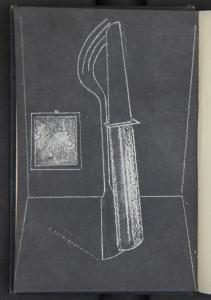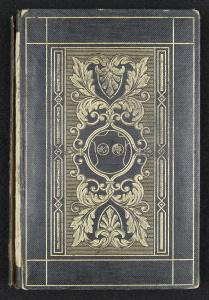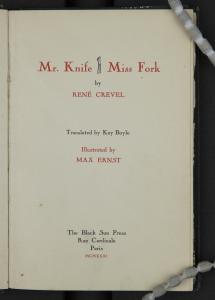

Mr. Knife, Miss Fork
1. The complaint, and the consolation; or, Night thoughts
2. The Fables of Æesop, and others / With designs on wood, by Thomas Bewick
5. News from nowhere: or, An epoch of rest, being some chapters from Utopian romance
6. The nature of Gothic, a chapter of the stones of Venice
7. Daphnis and Chloe: a most sweet abd pleasant pastoral romance for young ladies
8. The Sphinx
10. Credo
14. Bible.Old Testament. Song of Solomon.
16. Kem byt’? / V. Mai︠a︡kovskiĭ ; ris. N. Shifrin.
17. The ghost in the underblows
19. Bateau ivre
UCLA Call Number: PQ2605.C86 B2E

Mr. Knife, Miss Fork
This image is of the frontispiece of the book Mr. Knife, Miss Fork. This illustration was created by the artist Max Ernst using the technique of the photo–gram. Ernst’s photo–grams are made by making a line drawing on translucent paper and laying the line drawing over an unexposed piece of photosensitive paper to make a single print. The image plays with the perspective of the subject matter in a way that represents the point of view of the protagonist of the story. The image is black ink on paper, and depicts Mr. Knife, and Miss Fork.

Mr. Knife, Miss Fork
This image depicts the front cover of the book Mr. Knife, Miss Fork. The binding is made from black cloth stamped in gilt.

Mr. Knife, Miss Fork
This image depicts the title page of the book Mr. Knife, Miss Fork. Using red and black ink on paper, it demonstrates some of the distinguishing features of a fine press book such as evenly spaced margins and letters, and a traditional format for the location of title credits.
Contribution date:
Creator: Crevel, René
Publisher: Black Sun Press
Publication Place: Paris
Date of Publication: 1931
Dimensions 18cm
Physical Description:
The binding is sewn with a cloth fabric that has been adhered over the stitching. The book is of average weight for its size. Board has been used for the covers, with a black cloth covering and gold stamped gilt. Upon opening the cover of the book the reader will notice what looks to be the remnants of something having been glued to the back of the first page. There is also pencil writing that is illegible. The title page is printed in red and black, a distinguishing characteristic of a fine press book. The book has 19 full–page black and white engravings done by the artist Max Ernst. The illustrations depict a knife and a fork standing together in a room before a painting, a classical male nude figure with a bird head and a crown, a classical female nude, a winged beast creature with an infant, and assorted unrecognizable abstract imagery. The page numbers are printed in red ink. Each of these illustrations are separated from the preceding page by parchment interleaving which has red ink text printed on them as part of the narrative of the book. The semi–transparent parchment pages with red text printed on them allow the reader a partial viewing of the illustration beneath. The text blocks are centered on each page with equal margins to the right and left, and a slightly larger top margin than the bottom margin. The typeface is a serifed font.
Provenance: Unknown.Condition:
The cloth cover is breaking away from the spine exposing the binding. The pages are yellowed with age, and several have separated from the binding and are loose. Some of the parchment paper that separates illustrations from the preceding page are in a delicate state, with some completely detached from the binding. The corners of the covers show wear. Some of the parchment interleave pages have a slightly tacky residue.
Additional Info:
Limited to 50 numbered copies on Hollande paper signed by the authors, 200 copies on finest bristol paper and also 5 special copies, each copy containing four of the original drawings – Colophon. Additional copies are held in several other university library collections including: the Getty Research Institute, the Huntington Library, San Francisco State Library, Yale University Library, Emory University Library, Art Institute of Chicago Library, Northwestern University, Southern Illinois University, Indiana University, and others.
This is a good example of livre d’artiste book. The book seems to operate more as book in the sense of traditional book format, than as a surreal object in and of itself.
Production details: Ernst’s photo–grams are made by making a line drawing on translucent paper and laying the line drawing over an unexposed piece of photosensitive paper to make a single print.
Interpretation:
Mr. Knife, Miss Fork by René Crevel is a notable example of a surrealist book collaboration. The book combines image and text in a way that was characteristic of the surrealists, who often sought to make associative connections that originated from the subconscious. A main focus and activity of the surrealists was to find ways to meld dream and reality, often through vehicles such as writing, painting, and film. Mr. Knife, Miss Fork offers the reader a traditional codex format of a surreal novel with illustrations by a well–known artist of the surrealist movement, the artist Max Ernst. In a traditional story a reader may usually expect to find an image that is explicitly related to the action of the story. In Mr. Knife, Miss Fork the reader is constantly confronted at regular intervals with dark primitive forms that seem to appear out of the dark. Situated thus, Ernst’s surrealistic images serve to heighten the emotional aspects of the narrative and add a weird uncanny subtext that seems to make sense, but is also abstract. Some of the partial figures depicted in Ernst&srquo;s illustrations seem vaguely recognizable but un–named. This practice of situating these kinds of images and text in order to elicit an experience of the sublime is a classic characteristic of surrealist works.
Although the book has many elements of surrealist art, the book follows a traditional book structure and format. In addition, the pairing of a well–known artist and a well–known writer by Carese and Henry Crosby, the founders of Black Sun Press and well known American patrons of the arts, helps to situate this book in the tradition of the livre d’artiste or fine press book. Other titles that the Black Sun Press has published include The Escaped Cock by D.H. Lawerence, and Alice in Wonderland by Lewis Carroll with illustrations by Marie Laurencin.
Bibliography
(Ernest, Max) Crevel, René. - Mr.Knife Miss Fork. 2014.
http://www.peterharrington.co.uk/rare-books/world-literature/mr-knife-mi...(accessed November 2014).
Camfield, William A. Max Ernst: Dada and the dawn of surrealism. New York, NY: Neues, 1993.
Drucker, Johanna.The Century of Artists' Books. New York City: Granary Books, 1994.
Hamalian, Linda.The Cramoisy Queen: A Life of Caresse Crosby. Carbondale: Southern Illinois University Press, 2005.
Minkoff, George Robert. A Bibliography of the Black Sun Press. New York: Great Neck, 1970.
Mitchell, Breon (compiler).Beyond Illustration: The Livre: The Livre d'artiste in the Twentieth Century. Lilly Library. 1967.
http://www.indiana.edu/~liblilly/etexts/beyond/ (accessed 2014).
Rota, Anthony. "Book Bindings from Boards to Linson." In Apart from the Text, by Anthony Rota, 98-123. New Castle, Delaware: Oak Knoll, 1998.
Schofield, Will. Babylon. 2008. http://50watts.com/Babylon (accessed November 2014).
Verheyen, Peter D. Glossary of Binding Terms. 1996.
http://www.philobiblon.com/gbwarticle/bindterm.htm (accessed November 2014).
Vicari, Justin. Mad Muses and the Early Surrealists. Jefferson, NC: McFarland and Co., 2012.
Text Content Description :
The text of this book questions what the condition of death might be. Throughout the book death is associated with other living states of being or human activity, and with performative roles. The text is a surreal and fictional narrative told from the perspective of a little girl. Throughout the narrative, the protagonist of the narrative, the little girl, ponders the nature of death in relation to her own life. The narration also tells of a father, the son of a neurologist that has run off with a woman (the little girl’s cousin). By page 14 we have the moment where the narrator of this story projects the characters of her father onto a knife and the woman with whom he has run away onto a fork, and the tablecloth stands in for the Atlantic Ocean. From this point in the story the little girl invents a system of make–believe in which her “father,” the knife, and his “mistress,” the fork, plan their romantic departure together. The daughter seems to have interpreted the event of her father’s romantic trajectory as something of wonderment and endearment as she seems to resent the dour conservative attitudes espoused by her mother and grandmother. The book closes with the little girl hearing an “invisible murmur,” “With a hey and a ho and a hey nonino.” This final line is from a suggestive lyrical passage from William Shakespeare’s pastoral comedy titled As You Like It.
Contributor: Jonathan Ballak